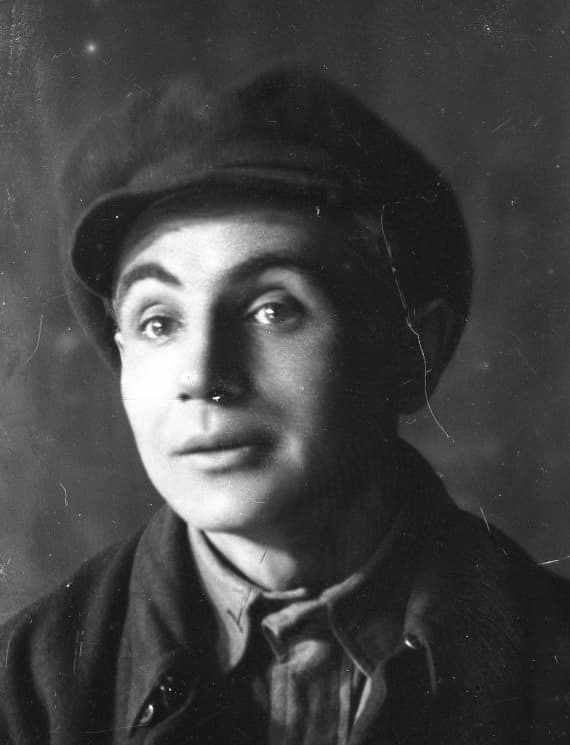Based on the play by Volodymyr Vynnychenko
Premier: September 24, 1917
Director: Les Kurbas
Set Design: Mykhailo Boichuk
Kornii Kanevych (White Bear), Artist – L. Kurbas
Hanna Semenivna, His Mother – A. Smereka, O. Horodyska
Ryta (Black Panther), His Wife – P. Samiilenko
Snizhynka/Snowflake – O. Dobrovolska
Mulen, Critic, Journalist – Y. Shevcheko
Yanson – M. Tereshchenko
Migueles – V. Vasyliev
Black – I. Levchenko, V. Kalyn, O. Kozub
Cardinal – O. Vatulia, V. Vasylko
Safo – S. Manuilovych
Lemonier – F. Chernukha, F. Lopatynskyi
Mimi – O. Aistra, O. Rokytianska
Shtif – S. Bondarchuk
Doctor – O. Kharchenko, O. Yurskyi
Black Panther and White Bear, inspired by Volodymyr Vynnychenko’s play, premiered at the Young Theater on September 24, 1917.
The actors recalled how Les Kurbas looked for plays that would help the theater grow creatively, but was rather unenthusiastic about Vynnychenko’s work. After the experience at the Young Theater he was no longer interested in the author’s work. He gave two reasons for choosing this specific play. Firstly, it raised the issue of the artist and society – something Kurbas always cared about. Secondly, Vynnychenko’s plays were money-makers: people eagerly bought tickets if they saw the modern playwright’s name on the posters. The young artists went with what was popular because they wanted to draw attention to their theater.
Vynnychenko’s play raises the issue of choosing between artistic calling and family obligations. At the heart of the conflict is artist Kornii (White Bear), who sees art as the meaning of life and has an irresistible desire to make a new painting, and his wife Ryta (Black Panther), whose life has become all about saving her son from death.
Kurbas put a psychological spin on the play at the Young Theater so that the actors could try their hand at the genre of psychological drama. Since the previous unofficial premier at the Young Theater was Bazar, another play by Vynnychenko, they already had experience in this genre and didn’t risk staging an experimental work.
The Young Theater was unable to create original scenery and costumes due to their financial difficulties, although artist Mykhailo Boichuk agreed to work on the show. Theater critic Hanna Veselovska wrote: “According to the memoirs of Berezil artist M. Symashkevych, who saw M. Boichuk’s sketches for Black Panther, the artist deliberately eliminated all signs of everyday life and made the designs very notional.”
The actors recalled how they took scenery from the Miniature Theater (the former Bourgogne Theatre), where the play premiered. It was the director and artist’s idea that each actor find their own costume or rent one from the Leifert brothers costume shop. Polina Samiilenko, the lead actress, sewed her own black dress.
Kurbas not only directed but also starred in the leading role of artist Kornii, the same role that he successfully played at the Ruska Besida Theater.
Critics and colleagues noted Kurbas’s skill in the role of Kornii. Actor Vasyl Vasylko recalled that Kurbas stood out with his professional excellence and called his performance a brilliant example of psychological realism. Critic Andrii Nikovskyi wrote that while the actor avoided melodramatics and played his role with restraint he seemed to underplay some scenes. However, since Kurbas was already an experienced actor by then, this could have been deliberate. Theater critic and historian Dmytro Antonovych was also critical and felt the role didn’t fit Kurbas’s temperament and nature as an actor but didn’t deny that the actor gave a talented performance.
Samiilenko was praised for her role as Ryta (Black Panther), although in some scenes she exaggerated her reactions and couldn’t control all her emotions. Kurbas was just beginning to get the young actors to control their reactions and gestures, but due to a lack of experience the actress wasn’t always able to do so. Nikovskyi wrote: “Dr. Samiilenko (the panther) played the role beautifully and were it not for her overly frantic outbursts, which were uncomfortable, there was almost nothing you could fault her with.” Antonovych noted that Samiilenko played her role with such temperament and strength that any shortcomings in her performance were secondary. Antonovych called Dobrovolska’s role as Snizhynka a jewel. “She played the part of Snizhynka confidently and smoothly,” he wrote.
There was much criticism of young actress Antonina Smereka’s portrayal of Kornii’a mother. The twenty-five-year-old wasn’t able to create a convincing image of an old woman. One reviewer wrote: “Smereka was completely out of place as Kornii’s mother. She didn’t convey the image of a mother, her voice was too young for an old person and her animated not old hands didn’t give the impression, even under the wildest imagination, that this was supposed to be the mother of an adult.”
Vasylko recalled that Yona Shevchenko’s (Mulen) acting stood out for his clear and graphic portrayal of the role, but probably because he was nervous during the premier he too could not completely control his emotions. Antonovych wrote a funny description of his performance: “Shevchenko, while able to control his hands, didn’t know where to put his feet and did something incredible with them.” Kurbas and Samiilenko also got knocked: “You can’t shove a sick child around on the couch the way Samillenko and Kurbas did. But those are minor details.”
Despite all the critics’ observations, the show was considered an undisputed victory for the young ensemble. Ticket sales boosted the actors’ spirits and they enthusiastically took to creating new shows.
Dmytro Antonovych had many comments about the show, but became a staunch supporter. After the premier he wrote: “I think you can say this is not an actor’s theater, but let’s not immediately attach labels. No matter how the theater does in the future, this time it was a winner.”

